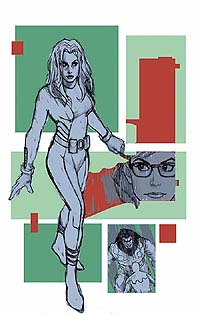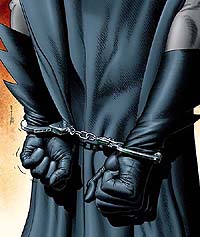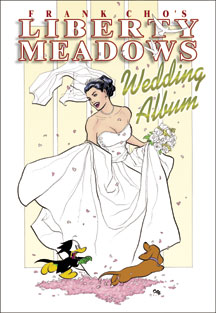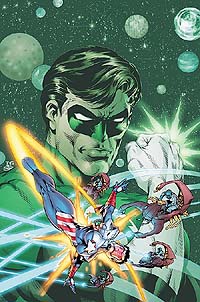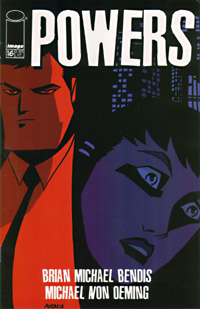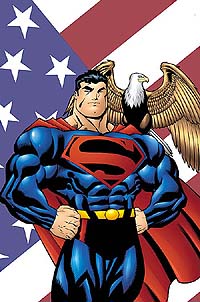|
Each week we take a critical look at some of the best books on the stands, courtesy of Big Guy's Comics (the unofficial comic book store of FanboyPlanet.com). If you publish a book that you want us to be covering, contact us. Or contact Derek. He doesn't have enough to do.
Hey Kids! Comics!
Birds of Prey #39
The Gun
writer: Chuck Dixon, artists: Rick Leonardi, Jesse Delperdang, and Albert T. DeGuzmanAfter a spotty record with the last cross-over, Dixon handles the demands of Bruce Wayne: Murderer much better. He manages to balance the ongoing subplots of the title while still moving forward the crossover story.
Oracle brings in the Black Canary to help her investigate the obvious frame of Wayne. As the title suggests, they focus on the murder weapon, while Barbara also reveals a keen legal mind - with law degree to go with it. And why not? Pre-Crisis, she was a Congresswoman.
This book also focuses on the myriad levels of secrecy within the bat-team. As a reader who only picks this book up during crossovers, I assumed that Black Canary did know Batman's identity (again, as she did in continuities past), but that's not the case. Though Oracle uses Dinah to investigate the case, she must also protect the exonerating secret from her teammate.
The same goes when dealing with Sasha. Both Oracle and Sasha know the secret, but neither one can reveal it to the other, even with Barbara serving as Sasha's attorney. (Although it's likely that Barbara would know that Sasha is the new blonde crimefighter running around Gotham with Batman.)
Of course, this book has a third hero running around, the unlikely and non-thematic Blue Beetle. Dixon lays the groundwork for him not running around much longer, a development that seems startling in a slap the forehead and say "of course!" kind of way. Given Ted Kord's history, it makes sense, and why hasn't anybody thought of it before?
The artwork makes for a mixed bag. Leonardi's pencils would seem just right for the characters, but the heavy-lined, angular inking ruins his light, fluid lines. However, his storytelling abilities still shine. And I've discovered a new favorite cover artist in Disney animator Phil Noto.
For that alone, I forgive DC this crossover event.
Rating:

Daredevil #29
writer: Brian Michael Bendis, artist: Alex MaleevReports of The Kingpin's demise are grossly exaggerated. Not even Bendis has the guts (or the editorial clout) to actually kill the big guy. But he isn't doing well at all. Fisk lies so close to death that he cannot stop his beloved Vanessa from getting involved in the family business.
This issue Bendis plays with chronology a bit to fill in some missing pieces. While last issue Matt discovered a hit on his life, it becomes apparent to us that that discovery occurred earlier than events three issues ago. The current arc is an intricate puzzle, but we can trust that we will get all the pieces, and Bendis lingers just enough on each clue to keep us from getting lost.
Maleev proves once again to be a great match for Bendis. His artwork carries a realistic tone, and he so excels at drawing the common men populating this story that the appearance of the red-garbed Daredevil is startling, almost out of place. Which, I suspect, is Bendis' growing point.
Kevin who?
Rating:

Gotham Knights #25
no exit
writer: Devin Grayson, artists: Roger Robinson and John FloydAt some point, somebody is going to recognize that that grim setting of the jaw belongs to both Bruce Wayne and Batman. (As, indeed, Batgirl realized last week.) Bruce plays even more of an enigma than usual. Granted, he's locked up, but his thoughts have not been betrayed to any of his "friends," nor to the reader. Everything we know so far comes about through the investigations of others.
Appropriate, then, that for the first time in a long while, he is peripheral in this book. It's truly his "knights" that carry the story, through their concern and reactions, and hopefully soon, their actions. Chief among them is Alfred, who hopefully will not have another out of character snit and disappear.
After all, had Alfred been at Wayne Manor, none of this would have been able to happen. (And what about Harold? I just like to ask that every year or two.)
The only glitch in the whole thing lies in Bruce's refusal to use Barbara as an attorney. He mysteriously says he needs her for "…other things." And yet, over in Birds of Prey, she confronts Sasha while acting as her lawyer. One day there will be a crossover free of such errors.
In the "Batman: Black and White" back-up slot, Mike W. Barr re-teams with Alan Davis and Mark Farmer to present a clever tale of a seedy nightclub that Batman relies upon for information. It's nice to see an old creative team together again, an acknowledgment that what came before had some pretty nifty moments.
Rating:

Liberty Meadows: Wedding Album
story and art: Frank ChoIt's not often that a book has to serve triple duty. Cho positions this Wedding Album to end his daily comic strip, catch the comic book readers up to the comic strip continuity, and serve as a jumping on point for new readers. Amazingly, he satisfies all three.
For those unaware, on December 30, Cho ended the Liberty Meadows strip with a cliffhanger and a phone number for readers to call to find their local comics shop. Tired of editorial interference, the freedom of doing his characters in a monthly comic seemed ideal, even though it probably meant a financial loss.
The monthly book has been reprinting strips for over two years, but several months behind the daily strip's publication dates, so many strips leading up to the cliffhanger had to get shoe-horned in here, more as a "best of" compilation highlighting Brandy's conflicted relationship with Frank and her fiancé Roger. Hopefully, he'll get around to reprinting the full story, but what's here gives enough of a taste that no one will be lost.
But first and foremost, Liberty Meadows is a humor strip, and so Cho also includes a heaping handful of some of the funniest hijinks of his animal cast, mostly focusing on Dean the Pig. This sequence includes most of the recurring elements of Cho's work: great sight gags, illustrations reminiscent of Wally Wood and Tex Avery, and the same dangerously unhealthy obsession with Star Wars that many fans share.
If you're a fan of Cho, you'll get this book regardless. If you've been looking for a way to introduce someone new to his work, this is a must have.
Rating:

Negation #2
writers: Tony Bedard and Mark Waid, artists: Paul Pelletier and Dave Meikis
reviewed by Charlie Wentling.The jailbreak that has been coming since the prequel issue two months ago happens. Obregon Kaine masterminds the escape of course, but stays further in the background this month than previously. The rest of the characters start to get fleshed out more, especially Evinlea.
The thing I like most about Negation is all of the cool details and twists. For example, the location of Westin's sigil made me laugh out loud. The story moves along at a much faster pace than other CrossGen titles. I think it may calm down a bit after this month now that the core group of characters is in place.
The art by Pelletier seems a bit more rushed than normal, but it's still good. If you're looking for a new series to try out, this is the one.
Rating:

Origin #4
Heaven and Hell
writer: Paul Jenkins, artists: Andy Kubert and Richard IsanoveAh, the critic-proof book finally releases its fourth issue. Detailing young "Logan's" time in a mining camp, we're moving maddeningly slowly along his path to becoming the man we know. And yet, every page is worth it.
Jenkins and Kubert have filled this book with little character details that grab the reader from the opening page. They established James as a boy rather easily distracted from reality even before his powers manifested, but now he has a reason. Even though Rose believes he remembers nothing of his first horrible night as a mutant, he spends much of his time holding his hands out and flexing them, trying to trigger the claws again.
Since nobody knows what he's doing, he gets in trouble a lot at the camp for dawdling. He also incurs the senseless wrath of the camp cook, a bully of a man who figures the boy for an easy target. While James takes punishment within the confines of civilization, he becomes more feral when out in the woods, and yet these two worlds do not collide. Yet.
It builds ominously, even as we should feel James' sense of liberation as he gets a handle on his abilities. But this looks like it may turn into a threat to Rose (who still looks too much like Jean Grey for comfort).
And all through it, I annoy myself with the question: which one of these guys is going to turn into Sabertooth?
Rating:

Peter Parker: Spider-Man #39
Operation: Octopus
writer: Paul Jenkins, artists: Mark Buckingham and Wayne FaucherEven though the annoyingly deadly Fusion returns, this issue makes a nice counter-point to the seriousness going on over in Amazing Spider-Man. Here we have a slightly loopy plot, though plausible in context of the Marvel Universe. We have a wry Spider-Man, a guy who sometimes gets a kick out of fighting super-villains. And he's got good deduction skills, as just might befit someone who has spent several years working as a newspaper photographer.
How seriously can you take a book that features a cyborg octopus, even if it is maiming corrupt politicians?
Peter stumbles across a plot by said corrupt politician to allow his closely connected friends access to advanced cybernetic technology. Something sinister must be afoot, but the Bugle won't publish it, having seemingly shifted into tabloid territory. Left to his own devices, Peter follows the trail to the long-missing Dr. Octopus, unaware that Octavius is in thrall to Fusion.
Like I said, it's fun. The only jarring detail really comes in J. Jonah Jameson's tabloid attitude, but looking around at the state of American journalism, the change may be long overdue. I just never thought it would happen to a hard-bitten newsman like JJJ.
Rating:

The Power Company: Skyrocket
First Gleamings
writer: Kurt Busiek, artists: Joe Staton and Christian AlamyBusiek introduces yet another new character who has really been around for a while in the DC Universe. At least six years, in fact. At least Striker Z had enough sense of continuity to not come to the United States until recently.
Skyrocket's origin plays out pretty much as we've seen many before. Celia Forrestal's genius parents invent a device that could be used as a weapon, though they intend it to benefit mankind. Mysterious enemies attempt to destroy the device, killing Celia's parents instead. She, of course, dons the device, an energy-controlling harness, to seek justice, teaming up with Green Lantern in the process.
What makes Skyrocket stand out, however, is that her military background actually gets used as part of her character. Usually that means an excuse to be a blowhard or a b***h, but Busiek rarely takes the easy way. Celia uses her training to adapt to her new abilities, and her military thinking looks like it will reflect in the way she tackles villains.
The retroactive continuity still rankles, but only because it seems so unnecessary. (And so unlikely - if Hal inspires Celia to become Skyrocket, you'd think he would have checked up on her before going insane and committing genocide - sorry, that's another point entirely…)
By giving us all these specials, Busiek has also set himself up. The actual Power Company title is going to be incredibly dense, since he has also so far established supporting casts for each individual.
Rating:

Powers #16
writer: Brian Michael Bendis, artist: Mike Avon OemingPilgrim has a disturbing dream about Walker, eloquently illustrated by Oeming. What it has to do with the current plotline remains to be seen, but it has definitely been bubbling under for some time.
She awakens in a hospital bed, put there after the questioning of Boogie Girl turned ugly. And fiery. As often happens with Powers, the solving of the actual mystery does not advance much. In fact, the feds have stepped in, leaving Walker and Pilgrim out in the cold.
Instead, Bendis and Oeming steep us in the detail of the Powers culture, giving us a superhero version of Politically Incorrect, and generally building a rich fiction. As almost an afterthought, we also get a crucial detail about Walker's career as Diamond.
This book just has that certain something that makes it a must buy every month. It may be the letters column; if you're skipping over that, you're really missing out. This issue Bendis even includes a transcript of a recent Q & A. Even as he abuses letter writers (damned funny), he clearly has great gratitude for all of us who read his work.
Rating:

Sigil #20
writer: Barbara Kesel, artists: Eduardo Barreto and John Dell
reviewed by Charlie Wentling.Sigil crosses over with Meridian this month. I guess I shouldn't say this is a crossover since CrossGen claims they don't do crossovers. What they mean is that they don't do the bad sort of crossovers like Our Worlds at War. This issue can be read on its own by people unfamiliar with Meridian, and readers of Meridian can skip it without missing out on any plot elements. But for people like me who already read both titles, it is a cool thing.
In spite of this, Sigil seems to be stuck in a rut. Not much has changed over the past four months. Sam has bounced himself to the world of Demetria and met Sephie. He does learn a few tricks from her, but his general reaction to her is that she uses her powers like a girl.
The guest art is by Eduardo Barreto, and he does fine. Maybe the pacing will pick up next month when Chuck Dixon comes on board.
Rating:

Sojourn #7
writer: Ron Marz, artists: Stuart Immonen and John Dell
reviewed by Charlie Wentling.The first half of this issue shows an interesting meeting between Neven and Mordath. We see that the power of the Sigil cannot hurt Neven. She gives Mordath a lot of information that he didn't have before. Her motives for doing so are unclear, but they are meant to be.
In the second half of the issue, Arwyn and Gareth begin their quest for the fragments of Ayden's arrow. Most of this is setup for the next few issues, but Ron Marz gives a cute/silly reason why Arwyn will always be wearing the same clothes.
Also, we get this bit of dialogue from Gareth when asked if he is married: "I'm, uh… you know… not the marrying kind." I could be reading this wrong, but it sounds to me like Gareth is gay. Maybe Marz is going for a Will and Grace type of relationship between these two characters? Something to think about anyhow.
Rating:

Superman #178
The American Way
writer: Jeph Loeb, artists: Ed McGuinness and Cam SmithFor dangerously unexplained reasons, Superman gets to be the first customer at the new Smallville General Store soda fountain. Sure, as a publicity stunt, it would work. But why would Superman be there? One onlooker theorizes that it has to do with Pete Ross being Vice-President, but that doesn't hold up, especially to President Luthor.
One of the onlookers takes a more than active dislike to this event, calling Superman out. The cover advertises the guest star as "The Spirit of America," but really, that's a subtitle. What Jeph Loeb has actually done is bring back Uncle Sam in all his original glory (actually, as drawn by McGuinness, a little shinier even).
Having Luthor in the White House has poisoned the American Spirit, who now harbors a grudge against the "alien" Superman. Not a subtle point, but one overdue, and it does cause the Man of Steel to question himself. Should he stand for something bigger than "the American Way?"
We Golden Age fans are more pleased that Uncle Sam has dropped that whole "The Patriot" guise, a concept created in John Ostrander's The Spectre that made a valid point for the two issues it appeared, but ruined a cool character. Loeb's solution is to acknowledge the identity and just proclaim it dead. No explanation; none needed, not even a dash of Hypertime.
And speaking of which, Luthor discovers a deadly secret, one he had been exposed to before. It will be interesting to see if that earlier incident still exists in his past.
Rating:

X-Force
Tick Tock
writer: Peter Milligan, artist: Michael AllredDoop pops a zit, opening a singularity in his head and sucking all the X-Force into their personal hells.
Yeah, that was pretty much it, making for the most surreal of all the 'Nuff Said books. It also provides one of the most challenging, in that Milligan gives Allred the chance to provide visual cues to everyone's personalities and darkest fears. If you look closely, you will learn a lot about the team, some things obvious, some things not. And even though the story seems to stand alone, some of these revelations will have repercussions.
It also makes Doop more formidable, adding to an already maddening mystery surrounding the character. The personal hells involve versions of Doop that may mean he has powers beyond imagining.
Congratulations to Milligan and Allred for working within the confines of the gimmick, (without cheating, Grant Morrison) and still delivering a story worth "reading."
Rating:

For alternate views and more books, check out Daryl Tay's site, Unique Frequencies.

All comics were reviewed by Derek McCaw unless otherwise noted.













